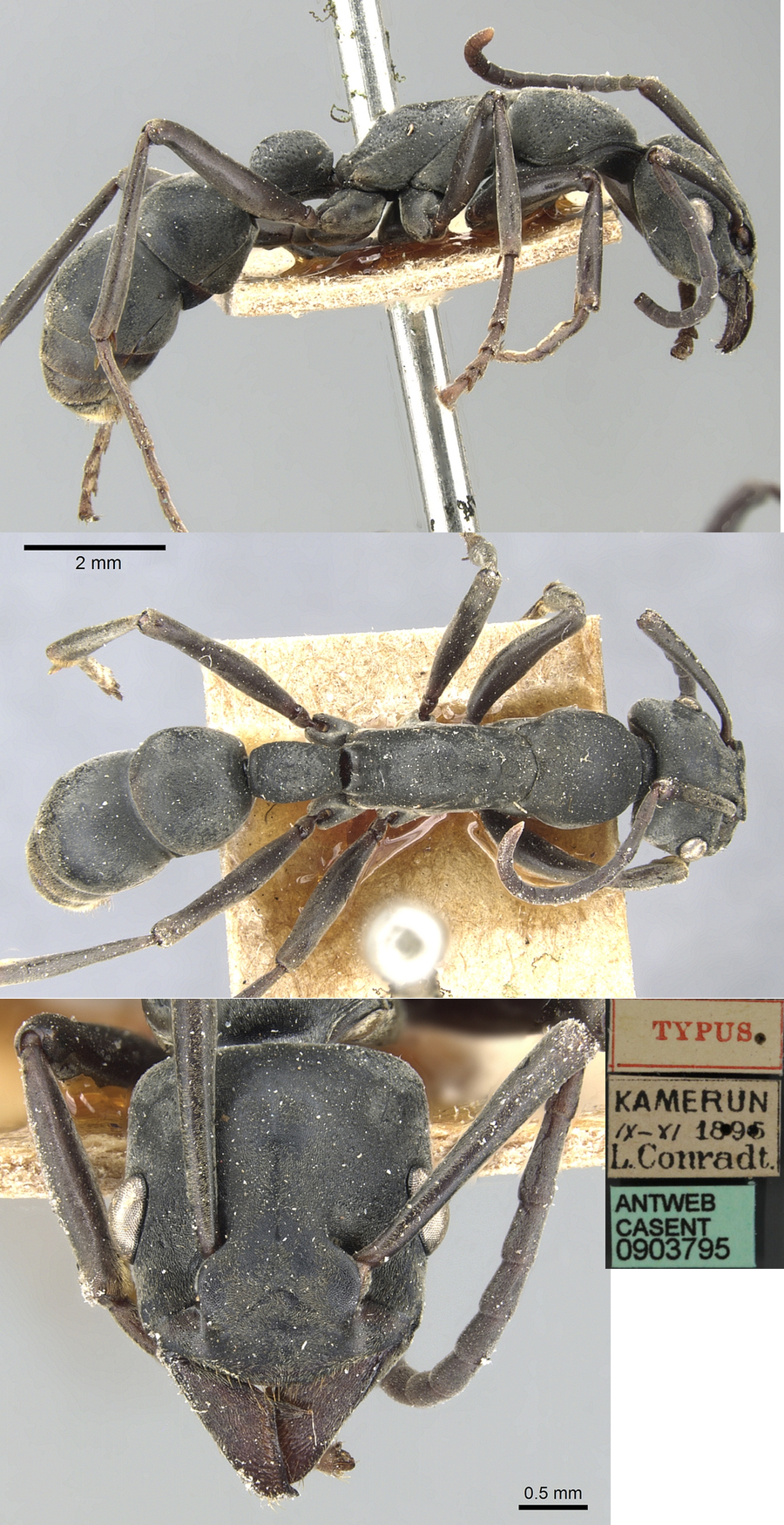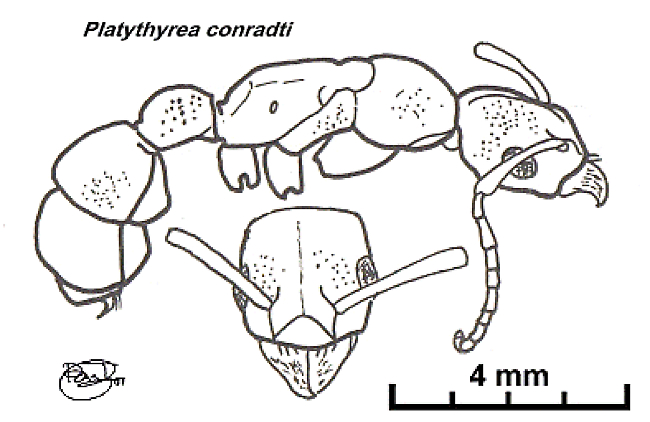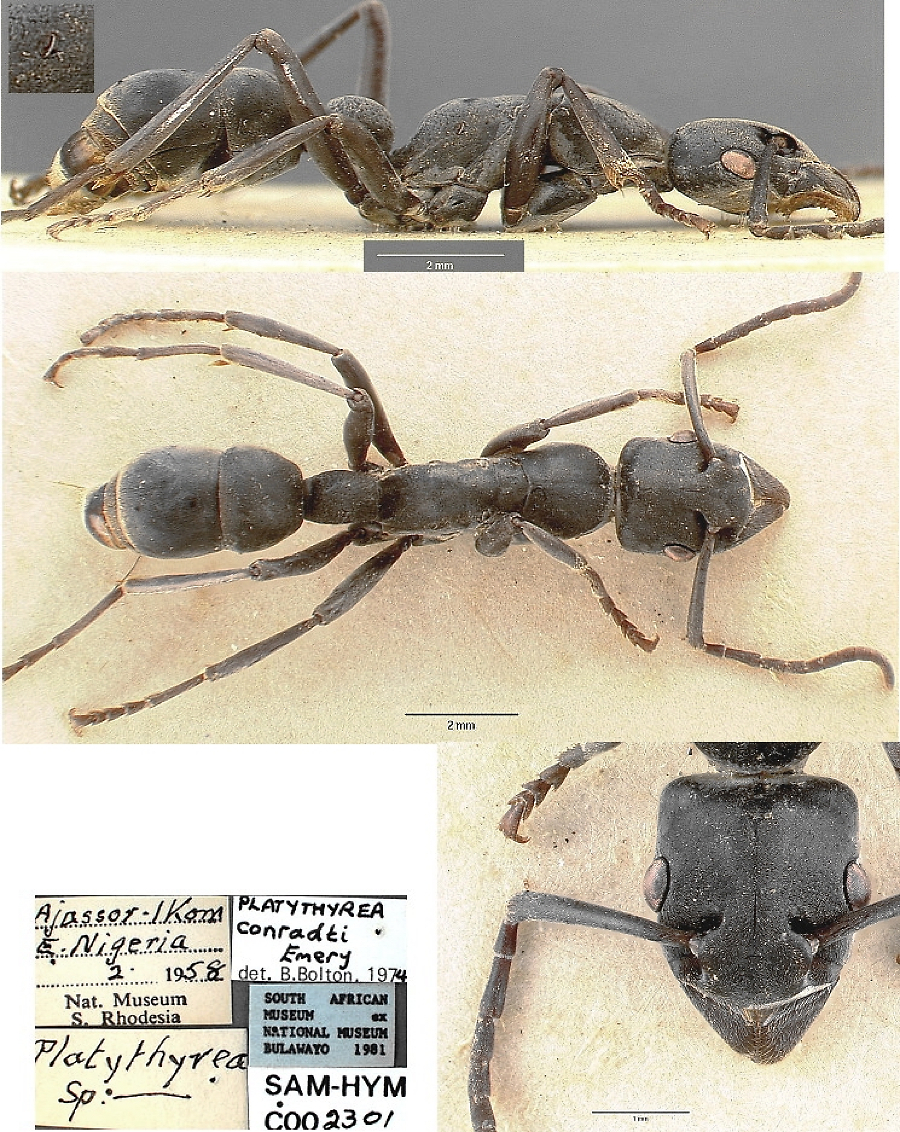Platythyrea conradti Emery
  Type location Cameroun (Platythyrea Conradti n. sp., Emery,
1899e: 464, worker & male) no location, collected by Conradt - see
below Type location Cameroun (Platythyrea Conradti n. sp., Emery,
1899e: 464, worker & male) no location, collected by Conradt - see
below
junior synonym monodi (Platythyrea
monodi n. sp., Bernard, 1952: 185, worker; synonymy Brown, 1975:
8) from Guinea,
Mt. Nimba, alt. 1000 m; 2.vi.1942, collector Lamotte - see http://www.antweb.org/specimenImages.do?name=casent0913730
worker and male
described (see Bolton, 1995)  . .
|
 Emery's (1899e) description
is at Emery's (1899e) description
is at  . Bernard's (1952) description of monodi
is at . Bernard's (1952) description of monodi
is at  . .
|
 The photomontage of the
type worker is
collated from http://www.antweb.org/specimen.do?name=casent0903795. The photomontage of the
type worker is
collated from http://www.antweb.org/specimen.do?name=casent0903795.
|
 Nigeria
specimens (Taylor, 1976: 9). WORKER. Size rather variable but
approximately: TL 12.5 mm, HL 2.55, HW 2.3, SL 2.55 and PW 1.87 Nigeria
specimens (Taylor, 1976: 9). WORKER. Size rather variable but
approximately: TL 12.5 mm, HL 2.55, HW 2.3, SL 2.55 and PW 1.87
Colour generally black but with dull grey appearance due to dense
pubescence, extremities red-brown. No denticles on propodeum or petiole.
Fairly common in Nigeria. Found on 1% or more of
cocoa trees at CRIN, but always in small numbers (Taylor, 1977). Nests
found in dead branch ends and crevices on live trees. Usually forage
singly on cocoa and surrounding shrubs, tend Homoptera and may build
debris tents. Listed by Eguagie (1971) from Agodi near Ibadan.
|
Wheeler (1922) noted a West Africa finding by Fulleborn;
plus others from Congo areas. The latter included the Forel (1915c)
note of Kohl's collection from in a small hollow tree trunk, at St.
Gabriel, Zaïre.
Bernard (1952) described monodi from a single
worker collected at Mt. Nimba, Camp IV, by Lamotte, 2.vi.1942. He
described the principal differences from conradti as being an
absence of the ashy-grey pubescence; and a considerably shorter and
more rounded thorax, specimen TL 11.0. The latter is clearly shown in
his illustration .
|
 Brown
(1975: 46) examined the monodi type and felt that it compared
well with specimens of conradti from the Banco Forest Reserve,
near Abidjan, Ivory Coast, although the monodi "has a
very slightly higher and shorter petiolar node"; a characteristic
shared with some specimens of conradti from French Congo(determined
by Santschi). He, Brown, had collected the Banco specimens
from a nest in a hollow trunk of a small living tree, with an entrance
about 1.5 m above ground. He noted also that the male had wings with a
distinctive light and dark pattern. The male I show below has
wings with the same pattern. Brown
(1975: 46) examined the monodi type and felt that it compared
well with specimens of conradti from the Banco Forest Reserve,
near Abidjan, Ivory Coast, although the monodi "has a
very slightly higher and shorter petiolar node"; a characteristic
shared with some specimens of conradti from French Congo(determined
by Santschi). He, Brown, had collected the Banco specimens
from a nest in a hollow trunk of a small living tree, with an entrance
about 1.5 m above ground. He noted also that the male had wings with a
distinctive light and dark pattern. The male I show below has
wings with the same pattern.
Colony size in Ivory Coast some 300-500 adults
(Lévieux, 1976a); feeding habits mainly eating moth larvae (Noctuidae)
(Lévieux, 1976c).
Given as fairly common on young cocoa in Ghana by
Strickland (1951a), who regarded it as a chance migrant from leaf
litter. Leston (1970) described it as a stump-nesting predatory ant and
the only ponerine which ascended trees. Later, however, it was found in
twenty-six of the 168 cocoa canopy samples collected by Room (1971) in
southern Ghana; it appears to have been found on those trees which had
none of the common dominant ants. Collected by pkd at Kade by Majer
(1975, 1976b) with 1-3 workers in two samples. Two workers were
collected by pkd from the canopy of Amelonado cocoa at CRIG by Bigger
(1981a), and it was found as a 'tourist' in one sample of leaf litter
at Old Tafo (Belshaw & Bolton, 1994b). Marchart (1968, cited in
Entwistle, 1972) used radiotracers to study predators of mirids and
found P. conradti to be among them; colonies are described as
being less than 100 strong and foraging solitary.
|
It
was among the non-dominant species recorded in the Cameroun
forest canopy studies at Campo
by Dejean and colleagues. They noted it as nesting in the middle
stratum only (hollowed branches) with 5 findings on the 30 trees
examined. Other studies in Cameroun by Déjean & Suzzoni
(1997) have thrown light on how the species is one of the few ponerines
able to be truly arboreal. This is attributed to its development of a
remarkable method of transporting sugary liquids. Ponerines cannot do
this by filling and distending the crop portion of the gut, unlike many
higher ants. What conradti has done is to utilise the surface
tension inherent in fluid droplets to transport sizeable amounts
adhering to the underside of the head and alitrunk. These collections
are taken back to the nest and mostly deposited on the walls of the
nest (where nestmates can imbibe) or deposited on the ventral side of
the larvae. As an added social element nest-mates also feed on droplets
while they are being carried, a form of mutual behaviour Déjean &
Suzzoni term the social bucket. The place of Platythyrea conradti
in the arboreal mosaic was described as non-dominant, the species
avoiding conflict with a dominant by being active only during the early
hours of the day, when Dejean & Suzzoni stated that dominants are
only slightly active.
|
Oxford University Museum
specimens
Platythyrea conradti
B Taylor det. |
Ivory Coast
Erena Dupont
ii.2014
|
Taï National Park
5˚45'00" N
7˚07'00" W
|
01
|
1
|
 |
Platythyrea conradti
B Taylor det. |
Ivory Coast
Erena Dupont
iii.2014
|
Taï National Park
5˚45'00" N
7˚07'00" W
|
10
|
1
|
 |
Platythyrea conradti
B Taylor det. |
Ivory Coast
Erena Dupont
v.2014
|
Taï National Park
5˚45'00" N
7˚07'00" W
|
07
|
7
|
 |
Platythyrea conradti
B Taylor det.
|
Benin
S Tchibozo
Benin 4
|
27.viii.2006
Bonou
06°50-55' N
02°20-30'E
|
Forêt de Gnanhouizoumè, Pitfall trap
|
1
|
 |
Platythyrea conradti
B Taylor det. |
Benin
S Tchibozo
|
29.i.2007
06°55’03.7 N
02°24’44.6 E
|
Forêt de
Gnanhouizoumè
Forêt fourmis (forest ants)
|
1
|
 |
Platythyrea conradti
B Taylor det. |
Benin
S Tchibozo
|
28.ii.2007
06°55’32.8 N
02°29’13 E
|
Forêt de Gbèvozoumè
Lisière fourmis (forest edge/ border ants)
|
1
|
|
Platythyrea conradti
B Taylor det.
Queen
|
Rep. of Congo
D De Bakker & JP Michiels
ex Y Braet
|
18.ix.2007
Mayombe
05°37'16" S
13°05'54" E
|
266 m asl
Canopy fogging
|
1
|
 |
Platythyrea conradti
B Taylor det.
Male
|
Central African
Republic
P Annoyer
Ei
|
01.ii.2005
Dzanga-Sangha
02°49'07.9" N
16°09'28.3" E
|
377 m; Camp 2; 20h-7h
Sur plate-forme à 35 m du sol dans un Azobé (Lophira alata, Ochnaceae)
|
1
|
 |
|
 The
photomontage is of a worker from Benin, Bonou, the Forêt de
Gnanhouizoumè; collector S Tchibozo (Benin 4). The
photomontage is of a worker from Benin, Bonou, the Forêt de
Gnanhouizoumè; collector S Tchibozo (Benin 4).
|
 The
photomontage is of a worker from Benin, Forêt de Gnanhouizoumè;
collector S Tchibozo (Benin 2010-01). The
photomontage is of a worker from Benin, Forêt de Gnanhouizoumè;
collector S Tchibozo (Benin 2010-01).
|
 The photomontage is
of a queen from Congo,
D De Bakker & JP Michiels; Mayombe, 18.ix.2007. The photomontage is
of a queen from Congo,
D De Bakker & JP Michiels; Mayombe, 18.ix.2007.
Is this a dealate queen or an "ergatogyne" or ergatoid
queen? I really do not know.
|
 The photomontage is
of a male from the Central
African Republic, Dzanga_Sangha NP, Camp 2; collector Philippe
Annoyer (CAR EL). The photomontage is
of a male from the Central
African Republic, Dzanga_Sangha NP, Camp 2; collector Philippe
Annoyer (CAR EL).
|
 The photomontage of a
worker from Nigeria is
collated from http://www.antweb.org/specimen.do?name=SAM-HYM-C002301A The photomontage of a
worker from Nigeria is
collated from http://www.antweb.org/specimen.do?name=SAM-HYM-C002301A
Collection Information; Specimen Code SAM-HYM-C002301A; Locality
Nigeria: Ajassor Ikom, E. Nigeria; 06°00'00"N 008°41'00"E; Collection
codes: SAM-HYM-C002301; Date: 1 Feb 1958; Collected by: Nat. Mus. S.
Rhodesia
|
|